





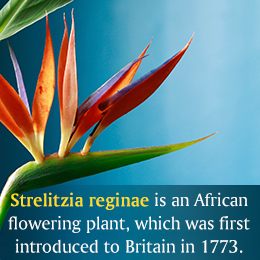 Quick Facts
Quick Facts
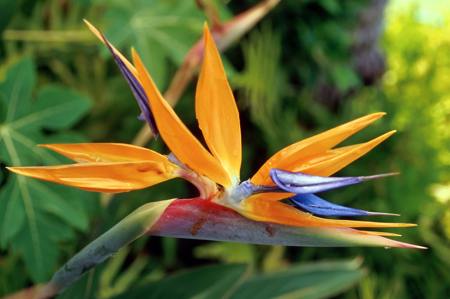 Strelitzia reginae is a flowering plant native to South Africa. It belongs to the family, Strelitziaceae and the order Zingiberales. It is one of the most popular perennial plants. It was first introduced to Europe in the year 1773, and then to other parts of the world. Its blooming time is autumn, winter, and spring. Strelitzia is a low-maintenance plant and is easy to care for. It can grow up to a height of six feet. Its large banana-like leaves are about 28 inches long. The beak-like casing from which the flower comes out is known as the spathe, which is at right angles to the stem. Due to this, the flower looks like a bird's head. The flower has three orange sepals and three blue petals. The flowering plant is known by various names such as Strelitzia, Crane Flower, or Bird of Paradise.Spathodea campanulata
Strelitzia reginae is a flowering plant native to South Africa. It belongs to the family, Strelitziaceae and the order Zingiberales. It is one of the most popular perennial plants. It was first introduced to Europe in the year 1773, and then to other parts of the world. Its blooming time is autumn, winter, and spring. Strelitzia is a low-maintenance plant and is easy to care for. It can grow up to a height of six feet. Its large banana-like leaves are about 28 inches long. The beak-like casing from which the flower comes out is known as the spathe, which is at right angles to the stem. Due to this, the flower looks like a bird's head. The flower has three orange sepals and three blue petals. The flowering plant is known by various names such as Strelitzia, Crane Flower, or Bird of Paradise.Spathodea campanulata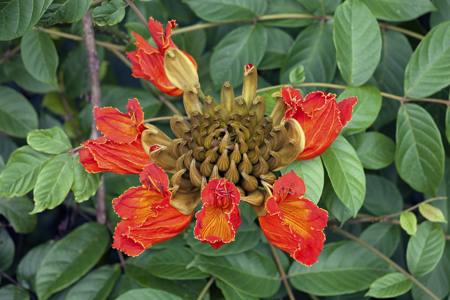 Spathodea campanulata is one of the most spectacular flowering plants that is indigenous to the tropical dry forests of West Africa. It belongs to the family Bignoniaceae and order Lamiales. The leaves grow about one to two feet long and have a bronzy color. The horn-shaped buds that appear in large clusters, are produced at the branches' tips. The lowest tier buds flare up into red orange (yellow in some cultivars) tulip-like bells. They also have crinkled margins. The flowers grow about 10 centimeters long. The tree flowers throughout the year, but the peak blooming season is spring. The plant is popular by the names fountain tree, African tulip tree, pichkari, or Nandi flame.Adenium obesum
Spathodea campanulata is one of the most spectacular flowering plants that is indigenous to the tropical dry forests of West Africa. It belongs to the family Bignoniaceae and order Lamiales. The leaves grow about one to two feet long and have a bronzy color. The horn-shaped buds that appear in large clusters, are produced at the branches' tips. The lowest tier buds flare up into red orange (yellow in some cultivars) tulip-like bells. They also have crinkled margins. The flowers grow about 10 centimeters long. The tree flowers throughout the year, but the peak blooming season is spring. The plant is popular by the names fountain tree, African tulip tree, pichkari, or Nandi flame.Adenium obesum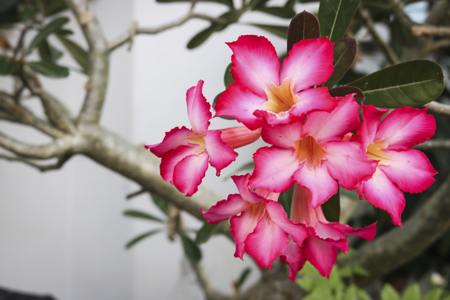 This flowering plant species belongs to the family Apocynaceae and order Gentianales. It is native to the Middle East, southern, tropical, and subtropical Africa. The tropical plant is tolerant to drought. The plant flowers in winter and lasts until summer. It grows around 3 meters in height. It has a thick trunk and a woody base known as caudex. Clumps of leathery leaves appear at the branch tips and are arranged in a spiral manner. The flowers are bell-shaped and beautiful. They have five petals and are around five centimeters in length. The flowers are red or pink in color often with a whitish flush. The popular names for the plant are Sabi star, kudu, mock azalea, impala lily and desert rose.Protea cynaroides
This flowering plant species belongs to the family Apocynaceae and order Gentianales. It is native to the Middle East, southern, tropical, and subtropical Africa. The tropical plant is tolerant to drought. The plant flowers in winter and lasts until summer. It grows around 3 meters in height. It has a thick trunk and a woody base known as caudex. Clumps of leathery leaves appear at the branch tips and are arranged in a spiral manner. The flowers are bell-shaped and beautiful. They have five petals and are around five centimeters in length. The flowers are red or pink in color often with a whitish flush. The popular names for the plant are Sabi star, kudu, mock azalea, impala lily and desert rose.Protea cynaroides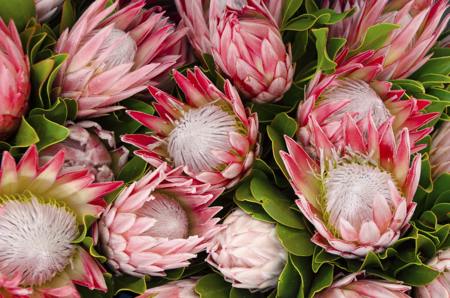 Protea cynaroides is an African flowering plant belonging to the family Proteaceae and order Proteales. It is found in the southern and southwestern parts of South Africa. It was named after the Greek God Proteus, the god who changes shape at his own will, as the flowers are found in various shapes. The plant is a shrub which has stout stems and dark green leaves. The vibrant flower head consists of a cluster of flowers at the center and is surrounded by colorful bracts, which can be light pink to deep crimson in color. The common names for the species are giant protea, honeypot, and king sugar bush.Gloriosa superba
Protea cynaroides is an African flowering plant belonging to the family Proteaceae and order Proteales. It is found in the southern and southwestern parts of South Africa. It was named after the Greek God Proteus, the god who changes shape at his own will, as the flowers are found in various shapes. The plant is a shrub which has stout stems and dark green leaves. The vibrant flower head consists of a cluster of flowers at the center and is surrounded by colorful bracts, which can be light pink to deep crimson in color. The common names for the species are giant protea, honeypot, and king sugar bush.Gloriosa superba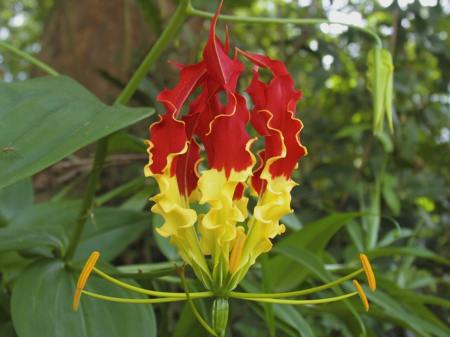 Gloriosa superba is a tuberous herb that belongs to the family Colchicaceae and order Liliales. It is widely distributed in tropical and southern Africa and in tropical Asia. The name of the flower has been given due to its bright red and yellow flowers. The name Gloriosa comes from the word gloriosus, which means good-looking and superba comes from the word superb, meaning splendid. It grows well in sandy-loam soil in sunny conditions. The petals of the flowers are elongated and wrinkled. The stamens are prominent and disperse outwards in graceful curves. The flower is around 5 centimeters in length. The leaves are bright green in color. All parts of the plant are extremely toxic due to the presence of alkaloids so ingestion can cause death. The popular names for the species include common names like flame lily, climbing lily, creeping lily, glory lily, gloriosa lily, tiger claw, and fire lily.Aloe arborescens
Gloriosa superba is a tuberous herb that belongs to the family Colchicaceae and order Liliales. It is widely distributed in tropical and southern Africa and in tropical Asia. The name of the flower has been given due to its bright red and yellow flowers. The name Gloriosa comes from the word gloriosus, which means good-looking and superba comes from the word superb, meaning splendid. It grows well in sandy-loam soil in sunny conditions. The petals of the flowers are elongated and wrinkled. The stamens are prominent and disperse outwards in graceful curves. The flower is around 5 centimeters in length. The leaves are bright green in color. All parts of the plant are extremely toxic due to the presence of alkaloids so ingestion can cause death. The popular names for the species include common names like flame lily, climbing lily, creeping lily, glory lily, gloriosa lily, tiger claw, and fire lily.Aloe arborescens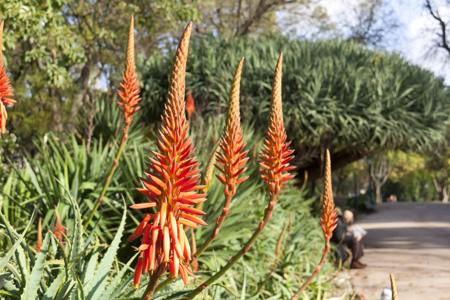 Aloe arborescens is a winter blooming flowering perennial plant, which belongs to the family Xanthorrhoeaceae and order Asparagales. It is found in the south-eastern parts of South Africa. The plant grows at a height of around 2 to 3 meters. The flowers are arranged in a raceme and are cylindrical in shape. They are bright red to orange in color. Its leaves are green with small spikes at the edges. The plant is also known as krantz aloe and candelabra aloe.Arctotis
Aloe arborescens is a winter blooming flowering perennial plant, which belongs to the family Xanthorrhoeaceae and order Asparagales. It is found in the south-eastern parts of South Africa. The plant grows at a height of around 2 to 3 meters. The flowers are arranged in a raceme and are cylindrical in shape. They are bright red to orange in color. Its leaves are green with small spikes at the edges. The plant is also known as krantz aloe and candelabra aloe.Arctotis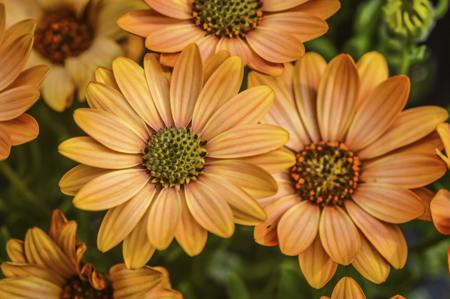 Arctotis is a perennial plant which belongs the family Asteraceae. It is popular by the name African Daisy. The flowers are spectacular and are daisy-like in appearance. They have a variety of colors like creamy to pale yellow, orange and others. The centers of the flowers are black. The blooming season is from spring to summer. The flowers tend to close in the late afternoon or in dull weather.Carpobrotus edulis
Arctotis is a perennial plant which belongs the family Asteraceae. It is popular by the name African Daisy. The flowers are spectacular and are daisy-like in appearance. They have a variety of colors like creamy to pale yellow, orange and others. The centers of the flowers are black. The blooming season is from spring to summer. The flowers tend to close in the late afternoon or in dull weather.Carpobrotus edulis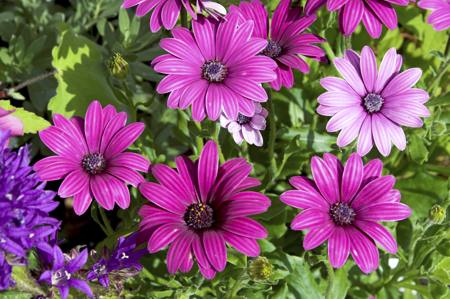 Carpobrotus edulis is a flowering plant native to the coastal areas of South Africa. It belongs to the family Aizoaceae and order Caryophyllales. Common names for it are hottentot, ice plant, highway ice plant or pigface. The flowers are large, daisy-like and purple or dark pink in color. They bloom especially during late winter-spring. The ground-hugging succulent perennial has succulent leaves which are used as an antiseptic to treat sore throat.Dimorphotheca pluvialis
Carpobrotus edulis is a flowering plant native to the coastal areas of South Africa. It belongs to the family Aizoaceae and order Caryophyllales. Common names for it are hottentot, ice plant, highway ice plant or pigface. The flowers are large, daisy-like and purple or dark pink in color. They bloom especially during late winter-spring. The ground-hugging succulent perennial has succulent leaves which are used as an antiseptic to treat sore throat.Dimorphotheca pluvialis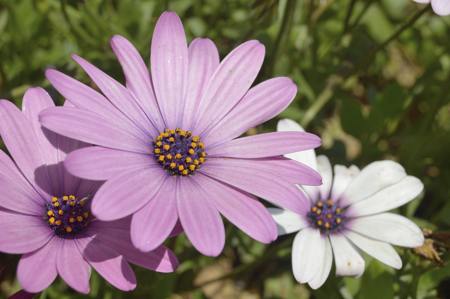 Dimorphotheca pluvialis is a tropical plant species that belongs to the family Asteraceae and order Asterales. The plant is also known by the names Ox-Eye daisy, Cape Daisy, or Rain Daisy. It is indigenous to South-West Africa. It grows up to a height of around 40 centimeters. Its blooming season is mid-spring to mid-summer. This annual herb has long and narrow leaves. The flowers are characterized by disc florets and ray florets. The ray florets are white to yellowish often with blue to purple markings. The disc florets are yellowish often with purplish markings. Their leaves are fleshy and succulent which help them to survive in droughts or harsh conditions. The leaves have very minute holes to absorb water.Gazania rigens
Dimorphotheca pluvialis is a tropical plant species that belongs to the family Asteraceae and order Asterales. The plant is also known by the names Ox-Eye daisy, Cape Daisy, or Rain Daisy. It is indigenous to South-West Africa. It grows up to a height of around 40 centimeters. Its blooming season is mid-spring to mid-summer. This annual herb has long and narrow leaves. The flowers are characterized by disc florets and ray florets. The ray florets are white to yellowish often with blue to purple markings. The disc florets are yellowish often with purplish markings. Their leaves are fleshy and succulent which help them to survive in droughts or harsh conditions. The leaves have very minute holes to absorb water.Gazania rigens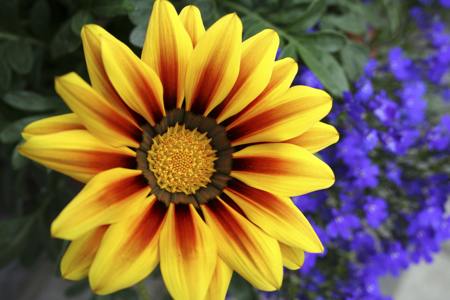 Gazania rigens is a Southern African annual plant that belongs to the family Asteraceae and order Asterales. It grows in masses, and to a height of around one and a half feet. Its leathery and finely lobed foliage enables it to survive in drought conditions. The flowers are daisy-like which have a wide variety of solid hues like bright yellow, red, orange, pink and white, or in various color combinations with contrasting patches or stripes. The flowers fully open up to face the sun, remain partially open during cloudy or rainy days and close at night. The blooming time is from late spring, summer to autumn. They are drought-tolerant and prefer sunny conditions for surviving. Gazania are also known by the names of African Daisy and Treasure Flower.Zantedeschia aethiopica
Gazania rigens is a Southern African annual plant that belongs to the family Asteraceae and order Asterales. It grows in masses, and to a height of around one and a half feet. Its leathery and finely lobed foliage enables it to survive in drought conditions. The flowers are daisy-like which have a wide variety of solid hues like bright yellow, red, orange, pink and white, or in various color combinations with contrasting patches or stripes. The flowers fully open up to face the sun, remain partially open during cloudy or rainy days and close at night. The blooming time is from late spring, summer to autumn. They are drought-tolerant and prefer sunny conditions for surviving. Gazania are also known by the names of African Daisy and Treasure Flower.Zantedeschia aethiopica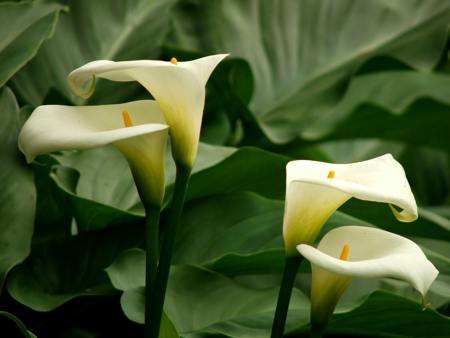 Zantedeschia is a herbaceous or semi-evergreen perennial that comes from the family Araceae and order Alismatales. It is endemic to South Africa and widely naturalized throughout the tropics. It grows in marshy areas. It is one of the most widely known plants. The perennial grows up to 3 feet in height. The leaves are long, spongy, and dark green, and shaped like an arrowhead. The flower is characterized by a light yellow spadix with many tiny flowers surrounded by a brilliant white, showy leaf-like bract or spathe. The blooming seasons are spring, summer, and autumn. It is also known as Arum Lily or Calla Lily.
Zantedeschia is a herbaceous or semi-evergreen perennial that comes from the family Araceae and order Alismatales. It is endemic to South Africa and widely naturalized throughout the tropics. It grows in marshy areas. It is one of the most widely known plants. The perennial grows up to 3 feet in height. The leaves are long, spongy, and dark green, and shaped like an arrowhead. The flower is characterized by a light yellow spadix with many tiny flowers surrounded by a brilliant white, showy leaf-like bract or spathe. The blooming seasons are spring, summer, and autumn. It is also known as Arum Lily or Calla Lily.
Copyright © www.100flowers.win Botanic Garden All Rights Reserved